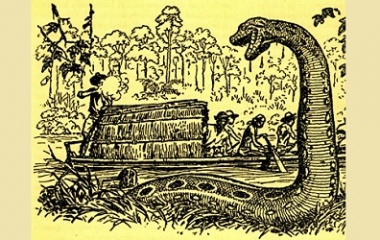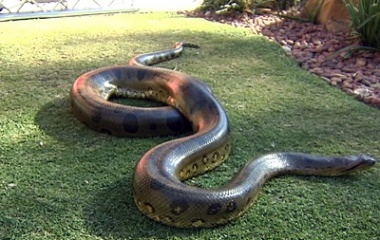A living, reptilian nightmare, the anaconda dwells in the dim jungles and sluggish rivers of the Amazon Basin. Anacondas are the apex predators of apex predators; they gorge on jaguars and crocodiles. Yet, according to legend, there might be a serpent even mightier than the anaconda hidden in the Amazon.
What is a Giant Anaconda?
The Giant Anaconda is an exaggerated version of the already monstrous anacondas living in South America. The legendary serpents are often reported as being two or three times the size of the largest anaconda to be scientifically documented.
Characteristics
Physical Description
Giant Anacondas are quite similar to regular anacondas; in fact, people who report seeing Giant Anacondas usually claim that the snake was a terrifically large specimen of the known species.
Pound for pound, the largest snake species in the world is the green anaconda. The largest green anaconda on record is 29 feet (8.8 meters) long and weighs 550 lbs. (227 kilograms) — a true gargantuan measuring a full 14 feet (4 meters) more than the average length. Still, Giant Anacondas dwarf even the largest green anaconda on record. Giants top the scales at 165 feet (50 meters) long.
Like regular anacondas, Giant Anacondas have dark green-grey skin and egg-shaped black spots. They may also have yellowish spots near their underbelly and orange bars that run from their eyes to their nightmarish jaws. Both their jaws and their skin can expand, allowing them to swallow meals of a ghastly size.
A terrible stench is sometimes associated with Giant Anacondas. Percy Fawcett, a famous explorer who reported encountering a 62-foot anaconda in Bolivia, described the stench as
“a penetrating foetid odor […] probably its breath.”
Other explorers reported a similarly unbearable smell, usually caused by the anaconda’s breath.
The Giant Anacondas of native legend are even more terrifying. They may be pitch black, have horns, or have large, fiery eyes.
Behavior
Most Giant Anaconda reports come out of South America, where vast swamps and marshes allow these monsters to lie hidden under the lilies. Giants have also been reported lurking in the dense jungle vegetation of the Amazon Rainforest and in some African rainforests.
Giant Anacondas are often spotted right after they’ve eaten. Crocodiles, jaguars, humans, and boats are said to be common prey, and the etymology of the word anaconda (which means “having killed an elephant” in Tamil) suggests that Giant Anacondas might be capable of tackling even larger prey.
Giant Anacondas are constrictors, just like their smaller relatives. They first attack their prey, pinning it between the inward-curving teeth of their massive jaws, then wrap coil upon mighty coil around their prey and squeeze until the heart stops beating. By some accounts, they might have breath so terrible or a gaze so fearsome that it can paralyze their prey before they attack.
According to native South American legends, Giant Anacondas may be shape-shifters that spend part of their lives in human form. Giant Anacondas are often depicted as guardians as well, sometimes barring the way to a hidden treasure, sometimes acting as protectors of nature itself.
Related Creatures
Although Giant Anacondas probably don’t slither the Earth today, the ancestors of today’s anacondas did reach giant proportions. Titanoboa is the largest snake species the world has seen. This prehistoric, Columbian monster is estimated to have reached lengths of 42 feet (13 meters) or more. Gigantophis, who held the title of the world’s largest snake before remains of Titanoboa were unearthed, lived in the Middle East and was capable of growing to 36 feet (11 meters) or more. Both snakes were constrictors, like the Giant Anaconda.
Beyond the fossil record, South American folklore is populated with numerous anaconda-esque monsters.
Yacumama is a Goddess who takes the form of a giant sea-serpent, believed by the indigenous people of Peru, Ecuador, and Argentina to inhabit the mouth of the Amazon River. Yacumama is also referred to as “the mother of the water” and is believed to have given life to all the animals in the sea.
Boitata is a river-serpent with fiery powers. According to Brazilian folklore, the Boitata was a cave-dwelling anaconda who developed an appetite for eating the eyes of his prey. After eating hundreds of eyes, his own eyes became filled with a furious fire, which he can now use to set fire to forests and fields. Fortunately, the serpent has a protective spirit and uses his power over fire to protect the forest and villages from errant flames, rather than setting the world ablaze himself.
Boiuna is a colossal, shape-shifting snake. He spends most of his time in the depths of lakes and slow-moving rivers, but when he does emerge from the water to travel through the jungle, he is so large that he fells trees and carves new rivers along his way.
M’boi is a serpent-god who lives in rivers. In a fit of rage, he broke the Earth and created the magnificent Iguazu falls, which can be seen at the border between Brazil and Argentina.
Cultural Representation
Origin
Legends about a great, water-dwelling serpent stretch far back into the murky depths of Amazonian culture, but “Giant Anaconda” lore wasn’t popularized until European colonists brought the influence of the more scientific western world to South America. Colonists may not have believed in the mystical powers that indigenous people assigned to their god-like snakes, but they were very ready to believe, and contribute to, reports of mammoth snakes hiding in the river.
Famous Reports
One of the most interesting aspects of Giant Anaconda mythology is its ability to capture the attention of both cryptozoologists (scientists who specialize in studying mythological or fringe species) and zoologists (who usually stand firmly in the skeptic’s camp about legendary creatures). Indeed, some of the most famous Giant Anaconda reports have come from mainstream zoologists.
In 1906, a famous British explorer named Percy Fawcett claimed that he shot a 62.3-foot (19 meter) anaconda while prowling along the Brazil-Bolivia border. The claim, however, did not stand up among his fellow naturalists back home. He was widely ridiculed for his Giant Anaconda story.
On the heels of Fawcett’s flop, Vincent Roth, a famous arachnologist who spent many years surveying the wildlife in Guyana, made a more plausible claim of having shot an anaconda that measured 33.8 feet (10.3 meters). Unfortunately, he was unable to produce evidence to support his claim.
Historian Mike Dash also published photos of Giant Anacondas, although his photos didn’t include objects which could be used as guides for scale.
Art and Literature
Although the Giant Anaconda is incredibly elusive in the real world, he is no stranger to the spotlight of fictional worlds.
One of Uruguay’s most beloved writers, Horacio Quiroga, wove Giant Anacondas into many of his jungle tales. Eventually, in 1921, he even named one of his books Anaconda, in honor of the powerful beast.
The Giant Anaconda is also a darling of Hollywood’s horror movie industry. The Anaconda movie series has grossed well over $200,000,000 and has seen crossovers with another popular horror movie franchise, Lake Placid.
Explanations of the Myth
There’s no question that the Giant Anaconda is inspired by real anacondas, which can grow to sizes that make them worthy of horror movie stardom even without embellishment.
So why does the idea of a bigger and badder anaconda persist?
Easy: people truly believe they’ve seen Giant Anacondas.
Estimating an anaconda’s size in the wild is extremely difficult. The animals are rarely stretched straight, ready to be measured. Their bulk is usually curved, coiled, or even submerged under water—so it’s easy for a person to imagine a few extra meters tacked onto these truly monstrous snakes.
Of course, some brave (and destructive) souls turn their anaconda sightings into anaconda killings, but even after an anaconda is killed, documenting its size in a credible way is difficult. Photographs can be edited, and snake skins can be stretched, so neither one is considered to be reliable evidence of a Giant Anaconda in the scientific community.
Myths thrive on uncertainty, and in the case of the Giant Anaconda, uncertainty has allowed for myth to grow to an incredible size.











Wow so large anaconda